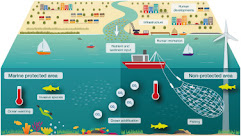Marine protected areas (MPAs) are areas of the ocean protected from human activity. They can be used to conserve marine life, protect habitats, and promote sustainable fishing practices.
Advantages of MPA:
Environmental benefits: MPAs help protect marine life and habitats. They can also help restore damaged ecosystems.
Economic benefits: MPAs can promote the development of tourism and fisheries. They can also create jobs and generate income for local communities.
Examples of MPAs in Portugal, France, Spain and the UK:
Portugal: Ria Formosa Natural Park is a marine protected area in Portugal. It is home to a variety of marine life, including dolphins, sea turtles and flamingos. The park is also a popular tourist destination, bringing in millions of euros in revenue every year.
France: Calanque National Park is a marine protected area in France. It is home to a variety of marine life, including fish, corals and sponges. The park is also a popular tourist destination, bringing in millions of euros in revenue every year.
Spain: The Cabrera Archipelago National Park is a marine protected area in Spain. It is home to a variety of marine life, including dolphins, sea turtles and monk seals. The park is also a popular tourist destination, bringing in millions of euros in revenue every year.
UNITED KINGDOM: The Blue Marine Foundation is a charity working to create marine protected areas in the UK. The charity has helped establish a number of marine nature reserves, including Lundy Marine Nature Reserve and South Devon Marine Conservation Area.
Marine protected areas are a valuable tool for protecting the environment and stimulating the economy. They can help conserve marine life, protect habitats, and promote sustainable fishing practices.

Comments
Post a Comment